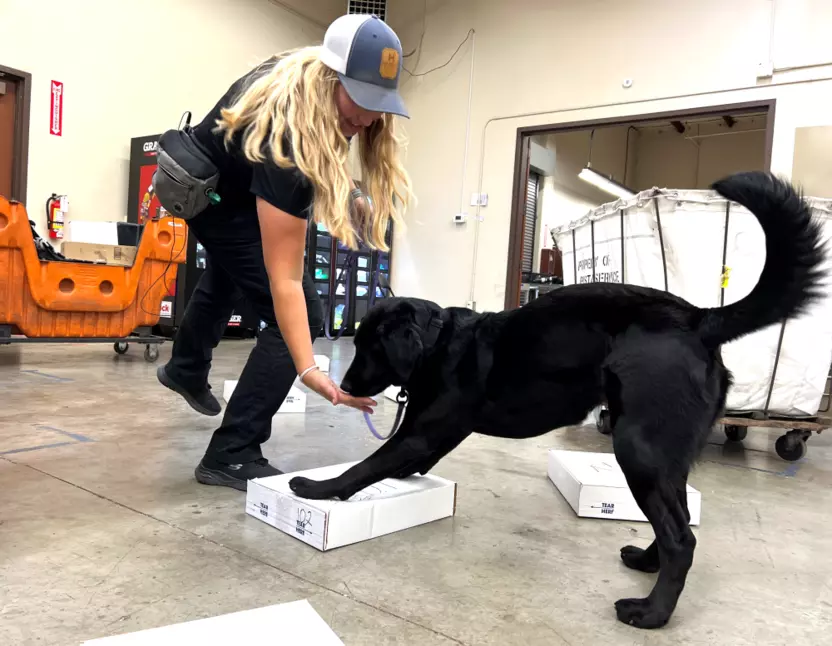New Agricultural Detection Dog and Her Handler Take on Bad Bugs
Everest, a 2-year-old black lab, and her handler, Jana Labrucherie, are helping to protect California's multibillion-dollar agriculture industry by intercepting shipments of mangoes, guava and other fruit containing non-native insects and pests
SANTA CLARA COUNTY, CALIF. – The County of Santa Clara has a new weapon in the battle to protect California agriculture from invasive pests: a rambunctious Labrador retriever whose likes include doggie treats and belly rubs.
Everest, a 2-year-old black lab, and her handler, Jana Labrucherie, have already made an impact in their first few months on the job, intercepting dozens of shipments of mangoes, guava and other fruit containing a wide variety of insects and pests.
Everest is trained to detect fruits that are known to host oriental fruit flies and other invasive insects that threaten the state’s more than $55 billion agriculture industry, which supplies nearly three-quarters of the fruits and nuts grown in the United States and roughly one-third of the vegetables.
Labrucherie and Everest form a formidable but friendly team. Labrucherie is a cheerful dog-lover who grew up on ranches surrounded by animals. Everest is an exuberant young retriever who, when she’s not working, enjoys racing around in circles and splashing in puddles.
Together, they inspect FedEx, UPS and DHL facilities throughout Santa Clara County, with Everest using her powerful sense of smell to detect what the human eye can’t see. She is trained to sniff out apples, citrus, stone fruits, mangoes and guava. These are the fruits that are most likely to carry invasive pests when they are shipped to California.

Labrucherie stepped into the job of dog handler for the County Division of Agriculture earlier this year after the previous dog handler departed. It’s a critical role in safeguarding the agriculture industry in Santa Clara County, which was valued at $359 million in 2022, and throughout California.
“Because of its size, location and diverse population, Santa Clara County is a gateway for non-native insects,” said Joe Deviney, the County’s agricultural commissioner. “The dog team is able to conduct surveillance at shipping facilities and intercept pests that might otherwise go undetected.”
Labrucherie, a biologist and standards inspector for the Division of Agriculture, started her new position this spring after attending an eight-week training in Georgia run by the U.S. Department of Agriculture (USDA). That’s where she paired up with Everest.
Working as a dog handler is not just a dream job for Labrucherie – it’s also in her blood. Labrucherie’s mother is the agriculture dog handler for Alameda County.
“I was raised on cattle ranches my whole life, so I’ve been around ag basically since I was born,” Labrucherie said. “It doesn’t even feel like a job when I get to hang out with a dog all day.”
Labrucherie jokes that her job is a “glorified poop picker-upper,” but it’s far more than that. It requires skill, patience, attention to detail, physical stamina and a natural touch with animals.
Everest and her handler typically start their workday doing inspections at shipping terminals. Everest finds and scratches packages containing target fruits. Labrucherie keeps her on task and makes sure she is safe amid all the bins and machinery.
Their many discoveries so far include:
- Nine unmarked fruit trees from Florida containing more than 20 pests, including mealy bugs and nematodes
- Five unmarked boxes, also from Florida, containing sugar apples, plums and other fruit along with six different pests
Once they are done with morning inspections, Labrucherie usually takes Everest for a hike to keep her healthy and stimulated and files paperwork regarding their finds with the USDA and California Department of Food and Agriculture (CDFA).
The County’s new dog team is making a difference, but they need help from the community in protecting the environment and economy of the South Bay. It’s important for county residents to follow federal and state laws governing what they are allowed to receive by mail or bring home when travelling.
The most common ways for invasive pests to enter California are when:
- Residents accidentally bring prohibited fruits and vegetables back from their travels or receive shipments of homegrown produce through the mail
- Smugglers intentionally circumvent agricultural checks to bring tropical fruit into the state
One of the most dangerous pests for California agriculture is the oriental fruit fly, which is native to Asia but has spread to multiple Pacific Islands, including Hawaii. The California secretary of agriculture recently placed a 112-square-mile portion of Santa Clara County under quarantine to combat an oriental fruit fly infestation.
Everest doesn’t know it, but she’s on the frontlines of the fight against fruit flies and lots of other bad bugs. And she makes for a really good partner.
“She’s just very sweet. She loves cuddles and scratches, and she likes a nice long nap after hikes,” Labrucherie said. “It’s hard to have a really bad day when you get to hang out with Everest.”
# # #
For more information on what agricultural items you are permitted to ship, visit the Don’t Pack a Pest website, which is a collaboration between the USDA, CDFA and other government agencies. If you come across produce that looks like it may be infested, or if you have any questions, you can also contact the County of Santa Clara Division of Agriculture at [email protected] or (408) 918-4600, or call the CDFA Pest Hotline at (800) 491-1899.